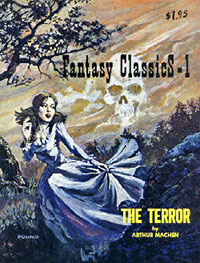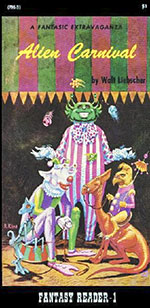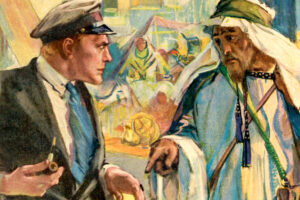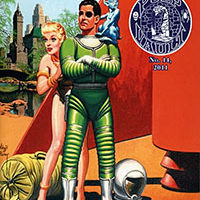 An interesting pair of reprint series from the early 1970s is Fantasy Classics and Fantasy Reader, published by the short-lived small press Fantasy House. These reprinted early (sometimes very early) fantasy stories from the pulps and other sources.
An interesting pair of reprint series from the early 1970s is Fantasy Classics and Fantasy Reader, published by the short-lived small press Fantasy House. These reprinted early (sometimes very early) fantasy stories from the pulps and other sources.
In addition to these two series, Fantasy House did a few other works. They started a pair of comic-book zines Infamous Funnies and Space Fantasies, both of which lasted only one issue.
They had a series called Fantasy House Paperbacks that had at least two volumes. I am only aware of the second one, a collection of Robert W. Chambers stories called “The Horror Chambers.” (Does anyone know what the first volume was?) And a facsimile reprint of Perly Poore Sheehan‘s “The One Gift.”
These works were edited by longtime SF editor and publisher Ken Krueger, who took over the publication of Fantasy Reader toward the end under his Shroud Publishers.
Fantasy Classics started first in 1973, with the intention of being published 12 times a year, but only five issues came out. All were 8.5×11 in size, with full-cover covers on heavy paper stock, and heaver then normal paperstock interiors with artwork, color in a few.
1. “The Terror” has as the title story a classic horror tale by Arthur Machen. Rounding out the volume is a two-page story from 1881, “The Elixir of Life” by Richard Garnett and a one-page story “An Odd Sort of People” by Sir John Mandeville (1372).
2. “Werewolf” has as the title story a werewolf tale by Clemence Housman from 1890. Included is “The Diamond Lens,” probably the first story of microscopic humanoid life from 1858, as well as a trio of stories from Weird Tales in the mid 1920s: “The Plant Thing,” “The Third Thumbprint” and “Tortoise-Shell Cat.”
3. “The Obsidian Ape” reprints the title work by Robert Neil Leath, taken from Munsey’s All-American Fiction pulp in 1938. This is a “lost race” tale set in Africa, much in the vein of A. Merritt or H. Rider Haggard.
4. “Ancient Sorceries” has as the title story one of Algernon Blackwood‘s tales of his occult detective John Silence. Here he is investigating a French village and its ties to devil worship. In addition are short stories from Amazing Stories and Weird Tales in the 1920s.
5. “The Jewel of the Seven Stars” has as the title story Bram Stoker‘s tale of Egyptian resurrection in Victorian England. Sadly, there is no information as to what they might have planned for the next issue.
Kicked off as a companion series after four issues of Fantasy Classics had come out, Fantasy Reader also promised to be published 12 times a year, but only saw seven issues in 1974 and ’75. Unlike its “big brother,” FR was published in an oblong size: 8.4×4. Except for #3, all had full color covers on heavy glossy stock. Interior artwork was black and white only.
 1. “Alien Carnival” was a collection of works by Walt Liebscher of various short tales. These were gathered into four groups: the Sexy Side, the Dark Side, the Gentle Side, and the Way-out Side, along with a selection of poems. A second “Alien Carnival” collection was promised, but it never happened.
1. “Alien Carnival” was a collection of works by Walt Liebscher of various short tales. These were gathered into four groups: the Sexy Side, the Dark Side, the Gentle Side, and the Way-out Side, along with a selection of poems. A second “Alien Carnival” collection was promised, but it never happened.
2. “Food for Demons” is a collection of works by E. Everett Evans, reprinted from a Spanish-language pulp magazine from Mexico, where they appeared between 1949-51. Interspersed with them are brief reminiscences by well-known SF authors about Evans.
3. “The Great God Pan” reprints Machen’s classic horror tale, along with an essay on Machen.
4. “The Maker of Moons” reprints a pair of works by Robert W. Chambers, better known for “The King in Yellow.” “The Maker of Moons” is a larger work, about a Chinese sorcerer trying to undermine our economy with fake gold. “The Demoiselle D’ys” is one of his tales from “The King in Yellow” collection.
5. “The Man Eater” is an interesting volume. It reprints a rare Edgar Rice Burroughs story. Originally serialized in a newspaper in 1915, it’s a jungle tale that’s obviously in the style of Tarzan. It had previously been reprinted in a pair of rare editions in the 1950s.
6. “Kings of Horror” reprints stories by Machen and Chambers. “The Inmost Light” by Machen, and “The Mask” and “The Yellow Sign” by Chambers. With this volume, the series is published by Ken’s Shroud Publications.
7. “Fearsome Island” reprints a tale from 1896 by Albert Kinross. It tells of Silas Fordred and his time on a mysterious island. As noted, this volume is published by Shroud Publishers, and actually reprints a volume Shroud had put out 10 years prior.
Overall, these were two great series. It’s unfortunate they didn’t last longer. I would have liked to have seen further volumes. I was fortunate several years back to get complete collections of both, I think from Bud Plant. Volumes can be found for various prices out there for those interested.
[UPDATED]


